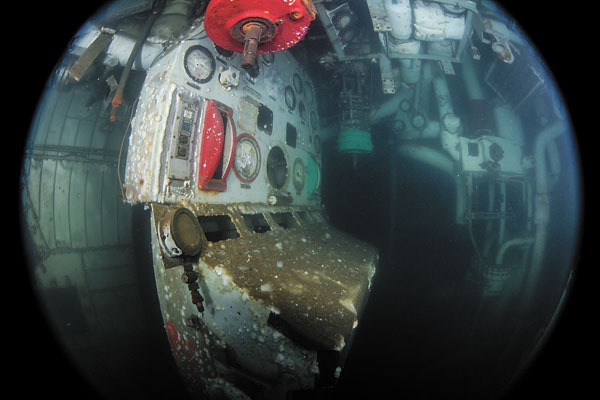Scientists to get an up-close view of B.C. artificial reefs
By Lookout on Sep 11, 2016 with Comments 0

The Vancouver Aquarium dive research team takes an underwater look at HMCS Annapolis. Photo courtesy of Artificial Reef Society of British Columbia
Peter Mallett, Staff Writer ~
The search is on for a few marine biologists and scientists from B.C.’s academic institutions to take a seat in a submersible and survey two vessels and one airplane deliberately sunken to create artificial reefs off the B.C. coastline.
The Artificial Reef Society of British Columbia (ARSBC) plans to recruit and send researchers to the murky depths of Halkett Bay, Princess Margaret Marine Park near Sidney, and Stuart Channel off Chemainus to validate their efforts in regenerating marine life with these unique habitats.
Researchers will climb into a Stingray 500 submersible provided by Vancouver firm Aquatica Submarines and Subsea Technologies. The submersible seats three and provides astonishing underwater visibility through its acrylic spherical hull.
“It will give us a chance to deliver undisputed evidence to confirm the net gain man-made reefs provide in the areas of limited natural complex marine habitat,” says Howard Robins, President of ARSBC. “There are still those who claim reefing ships are nothing less than dumping garbage in the ocean, but this mission will demonstrate that the repurposing of surplus ships, derelict vessels and aircraft does provide benefits for successive generations of marine life.”
British coastal freighter, G.B. Church was ARSBC’s first man-made reef, sunk in 1991 off Sidney. It was built in Goole, England, in 1943, and served in the Second World War as a supply ship for the allies in Europe.
A Boeing 737 donated to the Reef Society by Qwest Air Parts Inc. was sent to the bottom of Stuart Channel off Chemainus in 2006. The plane was mounted on 11-foot-high cradle support system and lowered by crane into the Georgia Strait.
Seventeen months ago the former Royal Canadian Navy warship Annapolis descended to its final resting place at the bottom of Halkett Bay in Howe Sound to form an artificial reef.
The upcoming expedition grew out of the ARSBC’s Annapolis Biodiversity Index Study that is already collecting data in cooperation with the Vancouver Aquarium and the Marine Life Sanctuaries Society, through grant funding from B.C. Parks.
Robins says it’s the first expedition of its kind his organization has undertaken, and possibly the first in the world for any group that “reefs” surplus and retired vessels.
Researchers will take photos and video to determine the extent of marine and plant life growing, and areas where it may not be flourishing. They will also check on how well these ships have been performing as long-term and stable reef habitat.
“In the end we want to have high-quality, documented evidence of the benefits of reefing as a viable alternative to scrapping [of ships],” says Rick Wall, communication director of the Reef Society. “This is just the first phase of our research mission, with the larger second phase planned for 2017 at which point we will visit five other large ships sunk around the province. The data collected will be shared and will help us plan for even more effective reefing solutions in the future.”
Before the expedition gets the green light in the fall of 2016, ARSBC and its affiliates must raise funds to cover the cost of renting the submersible and the 84-foot research vessel Ocean Surveyor.
More information about the expedition can be found on the ARSBC’s website artificialreefsocietybc.ca.
Filed Under: Top Stories
About the Author:





